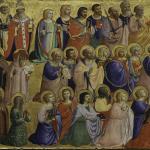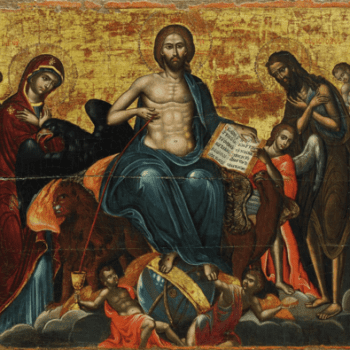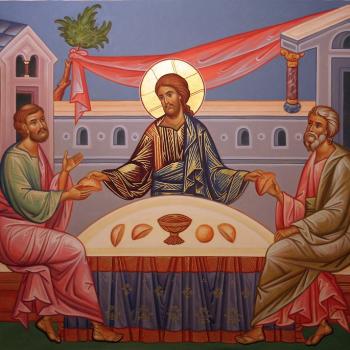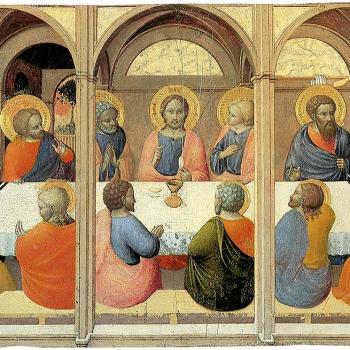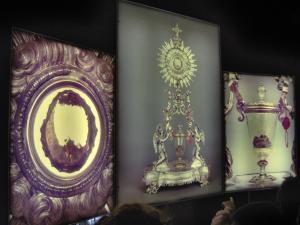
Just as the eucharist is often misunderstood, the meaning and value of eucharistic miracles are often misconstrued by well-intentioned, pious Catholics. Most of the time, eucharistic miracles refer to situations when the eucharistic species of bread and wine no longer appear as bread and wine but as flesh and blood. Another kind of miracle is when someone perceives a vision of Christ superimposed over the eucharistic bread. In either occasion, the miracle is meant to point out a truth about the eucharist, that is, it is Christ who is present sacramentally in it; what it is not meant to do is have people become too attached to the physical form, assuming more of the form than the reality behind the form.
In the Summa Theologica, St. Thomas Aquinas tells us not to consider the physical form of the eucharist, no matter what form it comes in, as being anything more than an accident which represents and presents to us the greater truth of in the sacrament itself. What is contained in every physical portion of the eucharist is the fullness of Christ, no matter the size of the portion received. Thus, the physical form, the accidents, is always less than what is being offered in communion, for what is offered is the fullness of Christ. This is true, whether or not the physical form is of bread and wine, or of flesh and blood. The form, even if it is of flesh and blood, points to the invisible grace given by communion, the grace found in the reception of the sacramental presence of Christ in all its fullness.
This is why Aquinas calls the appearance associated with a eucharistic miracle an apparition. He suggests that there are two ways this appearance could be manifest, either in the form of flesh and blood, or in the figure of a whole person (like a child). In either situation, the appearance is but a physical sign for a greater reality. Whether or not one receives communion in the form of bread or wine, or as flesh and blood (such as if the eucharist seems to change its accidents while being consumed), the person receives the exact same thing. It is Christ, and the fullness of Christ. Since mere flesh and blood do not show the fullness of Christ, it is why we know that such a form is but a sign for the reality of communion and is not the fullness of that reality itself. Aquinas points out, moreover, whether or not the miracle lasts for but a moment, or for some extended period of time, there is no change in what is received. What is important is the thing in itself, the sacramental presence of Christ. The value of eucharistic miracles is that they help those who witness them to understand the kind of grace being offered to them by the eucharist so that it becomes easier for them to believe that they truly receive Christ himself when they receive communion.
And so, Aquinas, presenting his position on eucharistic miracles, begins by saying:
I answer that, Such apparition comes about in two ways, when occasionally in this sacrament flesh, or blood, or a child, is seen. Sometimes it happens on the part of the beholders, whose eyes are so affected as if they outwardly saw flesh, or blood, or a child, while no change takes place in the sacrament. And this seems to happen when to one person it is seen under the species of flesh or of a child, while to others it is seen as before under the species of bread; or when to the same individual it appears for an hour under the appearance of flesh or a child, and afterwards under the appearance of bread. Nor is there any deception there, as occurs in the feats of magicians, because such species is divinely formed in the eye in order to represent some truth, namely, for the purpose of showing that Christ’s body is truly under this sacrament; just as Christ without deception appeared to the disciples who were going to Emmaus. For Augustine says (De Qq. Evang. ii) that “when our pretense is referred to some significance, it is not a lie, but a figure of the truth.” And since in this way no change is made in the sacrament, it is manifest that, when such apparition occurs, Christ does not cease to be under this sacrament. [1]
Aquinas finds important is that we realize that so long as such a miracle lasts, and is seen by many, we must not confuse the physical form as being anything other than what it is, a physical appearance which manifests and points to the greater truth of communion. That means that the fact that the fullness of Christ’s body does not physically appear, but only some portion of it seems to appear, we should not use that to think communion is the reception of some partial portion of Christ. Likewise, we must not think that, with such a physical appearance, Christ’s body is properly said to be located where the eucharistic species is found. Rather, his glorified body is beyond mere physical locality, as it is said to be in heaven:
But this seems unlikely. First of all, because Christ’s body under its proper species can be seen only in one place, wherein it is definitively contained. Hence since it is seen in its proper species, and is adored in heaven, it is not seen under its proper species in this sacrament. Secondly, because a glorified body, which appears at will, disappears when it wills after the apparition; thus it is related (Luke 24:31) that our Lord “vanished out of sight” of the disciples. But that which appears under the likeness of flesh in this sacrament, continues for a long time; indeed, one reads of its being sometimes enclosed, and, by order of many bishops, preserved in a pyx, which it would be wicked to think of Christ under His proper semblance. [2]
And so, what we see, like when we see bread and wine, or if we see flesh and blood, or some personal figure, it is always less than what we receive, meaning, it only serves to signify and present to us ways for us to realize that truth for ourselves. We must come to understand that Christ is spiritually and not physically present in communion, though he is received in and through the physical accidents of the sacrament itself. To those who would suggest this is deceptive on the part of God, Aquinas argues it is not, because God is truly trying to tell us something through the signs and what is being presented through them is truly what we are given when we partake of the eucharist:
Consequently, it remains to be said, that, while the dimensions remain the same as before, there is a miraculous change wrought in the other accidents, such as shape, color, and the rest, so that flesh, or blood, or a child, is seen. And, as was said already, this is not deception, because it is done “to represent the truth,” namely, to show by this miraculous apparition that Christ’s body and blood are truly in this sacrament. And thus it is clear that as the dimensions remain, which are the foundation of the other accidents, as we shall see later on (III:77:2), the body of Christ truly remains in this sacrament.[3]
From all of this, it must be said that eucharistic miracles are to be understood as being another way by which God signifies what it is we receive and it does so in a way which helps people believe that the Holy Spirit truly is at work with the eucharistic species, transforming them so that they can present to us the sacramental presence and reality of Christ. The physical form of communion, even after a eucharistic miracle, remains but a sign. The reality is greater than what is found in the sign. Eucharistic miracles serve to help people have faith in what they receive, but they should not therefore confuse the sign as being the fullness of what is received. That is, we receive the fullness of Christ, and not just what it is we can perceive with our empirical senses.
[1] St. Thomas Aquinas, Summa Theologica: Volume Five. Trans. Fathers of the English Dominican Provence (New York: Benzinger Brothers, 1948), 2455 ( III-76.8).
[2] St. Thomas Aquinas, Summa Theologica: Volume Five, 2456 ( III-76.8).
[3] St. Thomas Aquinas, Summa Theologica: Volume Five, 2456 ( III-76.8).
Stay in touch! Like A Little Bit of Nothing on Facebook.
If you liked what you read, please consider sharing it with your friends and family!


